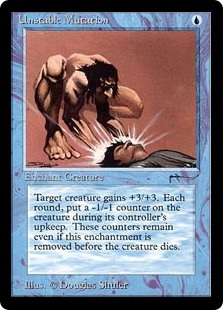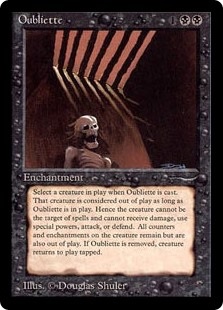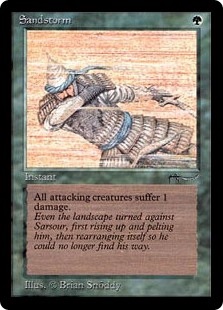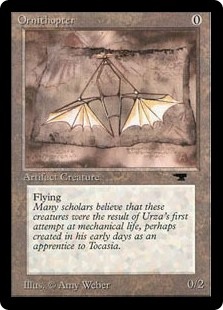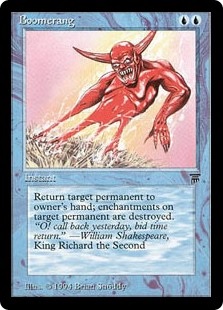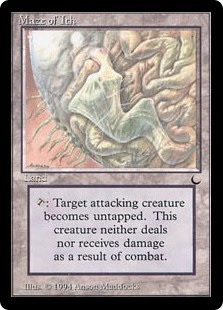Last week we looked at the most powerful commons in Magic's first edition: Limited Edition Alpha. It's pretty incredible just how much the power level of some of those first commons hold up. Many were on par with the most powerful uncommons and rares in that first set.
This week, we look at the standout commons of Magic's first four expansions: Arabian Nights, Antiquities, Legends and The Dark.
Which of these old cards skewer New World Order? Which cards have rates above the curve?
Take a look at the origins of some of Pauper's most powerful commons from '93-'94 Magic.
Arabian Nights
Unstable Mutation: The most powerful creature aura in early Magic gave us a hefty boost while only realizing a downside either until the fifth turn or the creature enchantment was removed. Most of the time it didn't matter. Toss this on a Flying Men and you have made your own angel.
Sadly, while receiving five paper printings, Unstable Mutation is not Pauper legal. The only MTGO printing was on the Timeshifted sheet to Time Spiral which MTGO counts as "Rares".
Cuombajj Witches: Black's first pinger is a oddball, and by today's standards, a definite color pie break. Created with a drawback to balance the card, the Witches might have been a powerful Limited card if it had ever been in a draftable set (besides Master Edition).
Cuombajj Witches is a tailor fit to the classic Mono-Black Devotion deck: it pings opposing Delver of Secrets and Spellstutter Sprites, gives two pips of Black devotion for Gray Merchant of Asphodel, and can finish off an opponent at a low life total without needing to attack.
Oubliette: This primordial version of Journey to Nowhere came with some bizarre rules baggage. A card that groks better than it plays (at least under the official Gatherer rules), it was the first card to temporarily exile a creature, let alone any permanent. Its ability was later revisited as a creature ability on Faceless Butcher from Torment before being changed into a White ability, seen today on cards like Journey to Nowhere and Fiend Hunter.
Oubliette is a notorious card in the world of paper Pauper for being the Black Lotus of Pauper. Due to card scarcity, the paper copies from Arabian Nights can run $30-$40 in spite of only being played in one deck, Mono-Black Devotion.
Kird Ape: Apes like trees. A heavily circulated common due to its later reprintings in Revised, Ninth Edition and Eternal Masters, Kird Ape was the original "Zoo" critter: a first turn two/3 thanks to Taiga. Latter descendants include Loam Lion and Wild Nacatl, the former scourge of Modern.
Naya Zoo is a fringe Pauper deck that utilizes the Domain mechanic to play 5-damage Tribal Flames and 5/5 Matca Rioters, mostly thanks to the rather innocuous Nylea's Presence.
Ghazban Ogre: The backbone of Aggro decks has always been 2-powered 1-drops, beginning as far back as the Alpha rare Savannah Lions. These ugly ogres were Green's first 2/2s for ![]() . Admittedly, the drawback is steep: donating your own Ogre to your opponent as punishment for their casting a Healing Salve. But as long as you were the aggro, the downside could be worth the cost, as witnessed on any number of 2-powered 1-drops printed since.
. Admittedly, the drawback is steep: donating your own Ogre to your opponent as punishment for their casting a Healing Salve. But as long as you were the aggro, the downside could be worth the cost, as witnessed on any number of 2-powered 1-drops printed since.
Pauper's Mono-Green Stompy deck eschews Ghazban Ogre in favor of better 2/2s for ![]() including Nettle Sentinel and the usually bloodthirsty Skarrgan Pit-Skulk.
including Nettle Sentinel and the usually bloodthirsty Skarrgan Pit-Skulk.
Sandstorm: The first of its kind, Sandstorm dealt a fixed amount of damage all creatures of a specific category without targeting, in this case, attackers. While this kind of effect certainly isn't strange to us now, found on cards like Tremor, Sandstorm was the first of its kind.
For a long time, Sandstorm was a popular Green sideboard card in Pauper, but today it has been passed over in favor of Scattershot Archer and Gut Shot as preferred ways to snipe Faeries.
Desert: One of Magic's first "Wingding" lands, Desert exchanged being able to generate a color of mana for the activated ability of being able to damage an attacking creature at end of combat. While not as utterly broken as Library of Alexandria or Bazaar of Baghdad, this land's ability can be subtly powerful, especially when stacked in multiples.
There is a debate today on whether Desert would be too strong for Pauper. But because Desert has never received a common printing on Magic Online that point is mute until further reprint.
Antiquities
Atog: The GOAT was the first of its kind: a creature that allowed you to sacrifice a resource for a temporary buff. While a few of Atog's descendants saw their share of Standard play, especially Psychatog, the original GOAT remains a popular card because of its artifact synergies, most notably the artifact lands from Mirrodin.
Affinity is alive and well in Pauper, powered by the artifact lands, and unlike Modern, cards that actually bear the Affinity mechanic. Atog + Fling is the combo kill that makes Affinity so feared.
Ornithopter: While long considered a trap card in Limited play, Ornithopter is a surprising Constructed staple both for being a zero cost artifact creature for Modern Affinity Robots and for just being a zero casting cost card for decks like Fruity Pebbles and Cheerios.
In Pauper, Ornithopter is a fringe player, but sees Constructed play in decks trying to abuse the Metalcraft mechanic, especially Blue Robots and White Cyborg.
The Urzatron: The Tron lands have emerged as the backbone of the multi-format Tron decks due to their ability to break the normal mana progression of the game. While one should be inherently limited in their ability to assemble the UrzaTron due to the 4-of card limit on each of its parts, powerful land searching cards like Expedition Map, Crop Rotation, and Sylvan Scrying have made the task of finding the missing land trivial.
While no Turn-3 Karn Liberated will ever haunt Pauper, there are still plenty of powerful things a Pauper player can do with almost unbounded mana. Currently, Tron decks in Pauper have occupied the spot of the big mana control decks, usually with a combo finish via Ghostly Flicker.
Legends
Boomerang: There is a very good reason that Boomerang got downgraded to Disperse: bouncing an opponent's lands, even at the cost of card, is merciless.
Boomerang is a fringe player at Pauper for Blue decks for its sheer flexibility because no other Mono-Blue card can boast the words "Target Permanent".
Force Spike: "Jerk Spike", as we call it in my casual playgroup, is a great example of how trading broad effectiveness for raw efficiency can still work well: Counterspell only costs ![]()
![]() , and Force Spike is a very very limited Counterspell, but the difference between
, and Force Spike is a very very limited Counterspell, but the difference between ![]() and
and ![]()
![]() can be enormous. Force Spike definitely saw its share of competitive play. And if we look at Force Spike's spiritual descendants, Daze, Spell Pierce and Stubborn Denial, we see a gallery of some of the best counterspells ever printed.
can be enormous. Force Spike definitely saw its share of competitive play. And if we look at Force Spike's spiritual descendants, Daze, Spell Pierce and Stubborn Denial, we see a gallery of some of the best counterspells ever printed.
Force Spike pops up once in awhile in Pauper, usually as a surprise 1-of, or in combination with Rhystic Study. Daze, however, is a Pauper star just as it plays in Eternal formats like Legacy.
Chain Lightning: There is no shame in effectively being a strictly worse Lightning Bolt when that still makes you the second best burn spell ever printed. The true power of Chain Lightning is in decks that want to play as many Red 3 damage spells for ![]() as they possibly can. Add in Lava Spike and Rift Bolt plus a complement of 1-drop creatures and you have a formidable clock in any sanctioned format.
as they possibly can. Add in Lava Spike and Rift Bolt plus a complement of 1-drop creatures and you have a formidable clock in any sanctioned format.
Chain Lightning is really only a staple of the Pauper Burn deck even though Lightning Bolt, its older, better looking cousin sides widespread play. No knock against Chain Lightning; Pauper is just a much deeper card pool than most observers imagine.
Honorable Mention:
The Kobolds: Seemingly worse versions of the Ornithopter, these almost meaningless creatures prove that any zero casting cost spell has potential given the right elements of combo pieces. While Phyrexian Walker and Shield Sphere were the 0-drops of choice in the classic Fruity Pebbles deck, style points go to anyone running kobolds to complete their infinite loops.
Sadly, the Kobolds see about zero Pauper play. But I have hope the right Pauper deck is out there once some twisted genius finds a way to mine their combo potential.
The Dark
Dust To Dust: The Dark had 2 powerful cards snuck in at common that were built-in two-for-ones. And impressively both of them exiled! While Ashes to Ashes feels more powerful on its surface, its life payment means that it has significantly less Constructed applications than the more modest Dust to Dust, especially in a world of Affinity, or in the case of Pauper, Affinity and other decks that run artifact lands.
In Pauper play, Dust to Dust is mostly a hard hate card against Affinity. Because it is more narrow than cards like Fragmentize or Kor Sanctifiers, Dust to Dust sees fringe sideboard play.
Holy Light: While not the most efficient way to Shrivel all the creatures, Holy Light is unique because it offers the ability both at instant speed and in violation of the modern color pie. Because it affects only non-White creatures, most of the time it plays like Cower in Fear.
Holy Light is a White sideboard card in Pauper against token decks and X/1s such as Mono Blue Delver and ![]()
![]() Bogles.
Bogles.
Ashes To Ashes: It is remarkable to me that this card got printed. Only the second Black card that allowed a player to exile creatures, Ashes to Ashes added only a single Black mana to the staple Terror and allowed the caster to exile TWO creatures. While five life is a hefty payment, by the standards of modern New World Order, this would easily be a premium uncommon.
Sadly, Ashes to Ashes is one of the handful of paper commons that has never had a common printing on Magic Online. Until then, Mono-Black Devotion can only dream...
Goblin Caves: Goblin Caves and Goblin Shrine were the first two tribal enchantments to care specifically for a creature type.
Because of their vulnerability to cards like Electrickery and Shrivel, Goblin Caves is a sideboard card against sweepers on par with Spidersilk Armor for Elves or Lumithread Field for tokens.
Maze of Ith: Though as rare as some of the uncommons, Maze of Ith was technically a C1, meaning this card would appear in the common slot of The Dark booster packs but at a significantly less frequent rate than other commons. Early Magic experimented with lands that didn't tap for mana. Some, like Oasis and Adventurers' Guildhouse were do-nothings. This one was definitely not.
Another "common" that will probably never be considered a common for Pauper legal purposes as its only Magic Online have been at Rare, but we can dream, can't we?
We'll be back next week with the next segment of Magic expansions: Fallen Empires, Ice Age, Homelands, and Alliances.
















